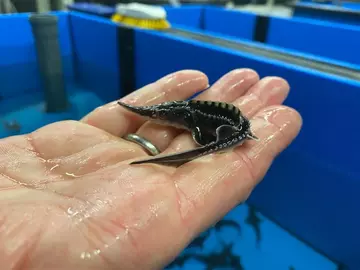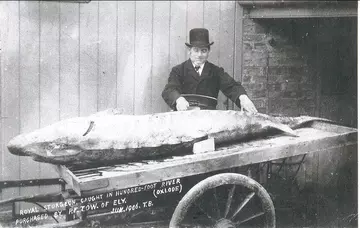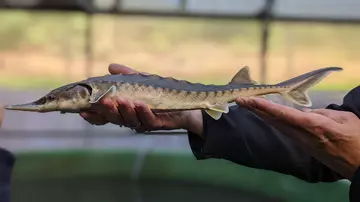
UK sturgeon action plan
An armour-plated fish once so popular that King Edward II declared it ‘royal’ is set to make a comeback thanks to an ambitious plan launched by UK conservationists to bring the ancient, Critically Endangered native sturgeon back to UK waters.
To mark Saturday’s historic Coronation, a team of conservationists led by ZSL have today (3 May 2023) launched the UK Sturgeon Conservation Strategy and Action Plan, a science-based guide developed by experts which meticulously outlines the action required to recover numbers of Atlantic and Critically Endangered European sturgeons in the UK.
Find out how we're making a difference for this Royal fish.
Big UK fish
Hannah McCormick, ZSL’s Conservation Project Officer for Estuaries and Wetlands, and one of the experts behind the plan, explained: “Growing up to 5m in length, with long whisker-like barbels and diamond-shaped armoured plates along their backs, sturgeons look like they’ve swum straight out of a paleontologist’s textbook.
“These impressive and ancient animals were once common in UK rivers and along our coastline, so it’s hardly surprising that they were declared “royal fish” by King Edward II back in the 14th Century, meaning all sturgeons landed in the UK have to be offered to the Crown – although nowadays this is just a formality.

“Fast-forward 700 years, and sturgeons have all but disappeared from our waters, after dam construction in rivers blocking their migration routes and overfishing caused numbers to plummet in the latter half of the 20th century.”
The team behind the action plan will be working with key stakeholders and river users to take the necessary steps towards sturgeon restoration – such as identifying essential habitats, the restoration of migratory passages and reducing accidental bycatch.
This UK-wide action plan forms part of a larger call to recover populations of the Critically Endangered royal fish, following successful conservation action in France and Germany helping to save European sturgeons from the brink of extinction.

Encouraged by increased recent sightings in UK coastal waters - following these major European reintroduction efforts - the team are working to make UK waters a safe space for sturgeon to make a royal comeback.
Ancient fish
Hannah continued: “The decline of sturgeons is a worldwide problem: these ancient fish outlived the dinosaurs and in fact still closely resemble their ancestors, which swam in Earth’s seas and rivers 100 million years ago. But after pushing them to the very brink of extinction, all 26 sturgeon species are under threat of being lost forever – earning them the undesirable title of being the most threatened group of animals of the IUCN Red List. The UK Sturgeon Conservation Strategy and Action Plan offers a solid, evidence-based way forward to restore the species – and a vital chance to save them.”
The actions outlined in the report include restoring the key UK coastal, freshwater and estuarine sturgeon habitats that sturgeons use throughout their lives, improving the connectivity of rivers and working with fishers to reduce deaths caused by accidental bycatch of the fish; important measures for providing safe habitats for native sturgeons and other marine life to thrive.
Both European and Atlantic sturgeons are fully migratory species – they begin their lives in rivers, before travelling out to sea where they will live most of their 60-year-long lives in coastal and marine waters, only returning to freshwater as adults every few years to reproduce. Protecting the full range of habitats that sturgeons rely on is essential for safeguarding their futures, and by taking urgent action to restore UK sturgeons, other species that live in the country’s waterways and coastlines will also benefit.

The action plan was created as part of the work of the UK Sturgeon Alliance, a team of scientists and conservationists from ZSL, Blue Marine Foundation, Institute of Fisheries Management, Wildfowl and Wetlands Trust, Severn Rivers Trust, and Nature at Work, working to restore native sturgeons through conservation action and education. The team are also urging members of the public to report any sightings to the Save the Sturgeon website – information which will help them work with partners to understand how sturgeons are using waters across the UK and Europe.
Hannah added: “It’s fitting that we mark the historic Coronation of King Charles III with the launch of this important plan to restore a once royal fish to the UK.”
Jenny Murray, Blue Marine Foundation’s Senior Restoration Projects Manager said: “The development of this Action Plan has been an exciting first step that contributes to the European efforts of restoring sturgeons. This has been a truly collaborative approach that has highlighted the interest and need to see habitats in a good enough condition for their return. The public can support sturgeons return by raising awareness of this beautiful species and reporting any sightings to the Save the Sturgeon website.”

Steve Colclough, Chair of the Estuarine & Marine Specialist Section at the Institute of Fisheries Management added: “We now have over 5,200 records of sturgeon in rivers, estuaries and coastal waters all around the UK, since at least 1700. Our waters clearly formed part of the natural range of these great migrators. Until recently, the numbers visiting us have been so low that these were only recognized as occasional vagrants. In the 18th and 19th century many fish were captured in our rivers and in some cases where they were not offered to the crown, they were removed and destroyed as strange exotic sea monsters. Now we know better, we can help conserve these flagship species for future generations to see.”
Tony Juniper, Chair of Natural England who wrote the foreword for the UK Sturgeon Conservation and Action Plan said: “Natural England are happy to have been able to contribute guidance in the form of science and evidence to this Action Plan and hope it provides the stimulus required to encourage further ambition for the recovery of this special aquatic species into our rivers, estuaries and seas.”
